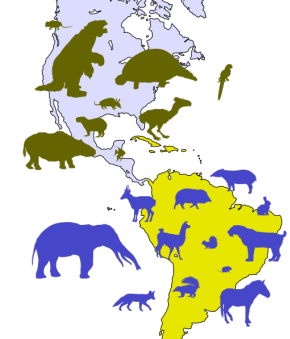As with other older geologic periods, the geological strata that define the start and end are well identified but the exact dates of the start and end of the epoch are slightly uncertain. The boundaries defining the onset of the Pliocene are not set at an easily identified worldwide event but rather at regional boundaries between the warmer Miocene and the relatively cooler Pliocene. The upper boundary was set at the start of the Pleistocene glaciations.
Pliocene Climate
During the Pliocene climate became cooler and drier, and seasonal, similar to modern climates. The global average temperature in the mid-Pliocene (3.3 Ma–3 Ma) was 2–3°C higher than today, global sea level 25m higher and Northern hemisphere ice sheet ephemeral before the onset of extensive glaciation over Greenland that occurred in the late Pliocene around 3 Ma. The formation of an Arctic ice cap is signaled by an abrupt shift in oxygen isotope ratios and ice-rafted cobbles in the North Atlantic and North Pacific ocean beds. Mid-latitude glaciation was probably underway before the end of the epoch. The global cooling that occurred during the Pliocene may have spurred on the disappearance of forests and the spread of grasslands and savannas.
Paleogeography
Continents continued to drift, moving from positions possibly as far as 250 km from their
Isthmus of Panama during the Pliocene, making possible the Great American Interchange and bringing a nearly complete end to South America's distinctive large marsupial predator and native ungulate faunas. The formation of the Isthmus had major consequences on global temperatures, since warm equatorial ocean currents were cut off and an Atlantic cooling cycle began, with cold Arctic and Antarctic waters dropping temperatures in the now-isolated Atlantic Ocean.Africa's collision with Europe formed the Mediterranean Sea, cutting off the remnants of the Tethys Ocean. The border between the Miocene and the Pliocene is also the time of the Messinian salinity crisis.
Sea level changes exposed the land-bridge between Alaska and Asia.
Pliocene marine rocks are well exposed in the Mediterranean, India, and China. Elsewhere, they are exposed largely near shores.
Flora
The change to a cooler, dry, seasonal climate had considerable impacts on Pliocene vegetation, reducing tropical species worldwide. Deciduous forests proliferated, coniferous forests and tundra covered much of the north, and grasslands spread on all continents (except Antarctica). Tropical forests were limited to a tight band around the equator, and in addition to dry savannahs, deserts appeared in Asia and Africa.
Fauna
Both marine and continental faunas were essentially modern, although continental faunas were a bit more primitive than today. The first recognizable hominins, the australopithecines, appeared in the Pliocene.
The land mass collisions meant great migration and mixing of previously isolated species, such as in the Great American Interchange. Herbivores got bigger, as did specialized predators.
Mammals
In North America, rodents, large mastodonts and gomphotheres, and opossums
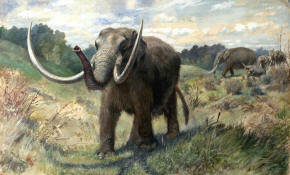 |
| Above: Mastodon Below: Ground Sloth (Eremotherium)(Picture Source) |
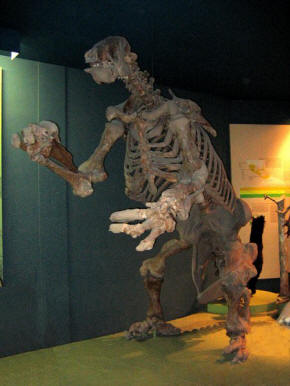 |
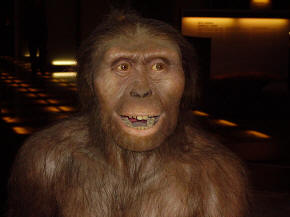 |
| Above:
Australopithecus afarensis (Picture
Source) Below: Macrauchenia |
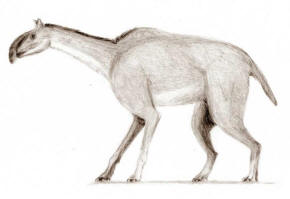 |
In Eurasia rodents did well, while primate distribution declined. Elephants, gomphotheres and stegodonts were successful in Asia, and hyraxes migrated north from Africa. Horse diversity declined, while tapirs and rhinos did fairly well. Cows and antelopes were successful, and some camel species crossed into Asia from North America. Hyenas and early saber-toothed cats appeared, joining other predators including dogs, bears and weasels.
Africa was dominated by hoofed animals, and primates continued their evolution, with australopithecines (some of the first hominids) appearing in the late Pliocene. Rodents were successful, and elephant populations increased. Cows and antelopes continued diversification and overtaking pigs in numbers of species. Early giraffes appeared, and camels migrated via Asia from North America. Horses and modern rhinos came onto the scene. Bears, dogs and weasels (originally from North America) joined cats, hyenas and civets as the African predators, forcing hyenas to adapt as specialized scavengers.
South America was invaded by North American species for the first time since the Cretaceous, with North American rodents and primates mixing with southern forms. Litopterns and the notoungulates, South American natives, were mostly wiped out, except for the macrauchenids and toxodonts, which managed to survive. Small weasel-like carnivorous mustelids and coatis migrated from the north. Grazing glyptodonts, browsing giant ground sloths and smaller caviomorph rodents, pampatheres, and armadillos did the opposite, migrating to the north and thriving there.
The marsupials remained the dominant Australian mammals, with herbivore forms including wombats and kangaroos, and the huge diprotodonts. Carnivorous marsupials continued hunting in the Pliocene, including dasyurids, the dog-like thylacine and cat-like Thylacoleo. The first rodents arrived in Australia. The modern platypus, a monotreme, appeared.
Birds
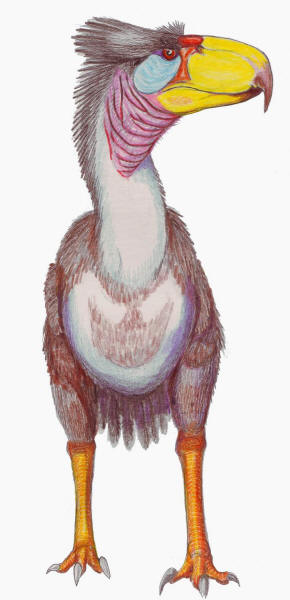 |
| Titanis |
The predatory South American phorusrhacids were rare in this time; among the last was Titanis, a large phorusrhacid that migrated to North America and rivaled mammals as top predator. Its distinct feature was its claws, which had re-evolved for grasping prey, such as Hipparion. Other birds probably evolved at this time, some modern, some now extinct.
Reptiles
Alligators and crocodiles died out in Europe as the climate cooled. Venomous snake genera continued to increase as more rodents and birds evolved. Rattlesnakes first appeared in the Pliocene. The modern species Alligator mississippiensis, having evolved in the Miocene, continued into the Pliocene, except with a more northern range; specimens have been found in very late Miocene deposits of Tennessee. Giant tortoises still thrived in North America, with genera like Hesperotestudo. Madtsoid snakes were still present in Australia.
Oceans
Oceans continued to be relatively warm during the Pliocene, though they continued cooling. The Arctic ice cap formed, drying the climate and increasing cool shallow currents in the North Atlantic. Deep cold currents flowed from the Antarctic.
The formation of the Isthmus of Panama about 3.5 million years ago cut off the final remnant of what was once essentially a circum-equatorial current that had existed since the Cretaceous and the early Cenozoic. This may have contributed to further cooling of the oceans worldwide.
The Pliocene seas were alive with sea cows, seals and sea lions.
End of Reading
Return to the Old Earth Ministries Online Earth History Curriculum homepage.
Source: Pliocene Epoch
